Proteins

A protein is one or more polypeptides held together by peptide bonds.
Theoretical proteins
Def. any naturally occurring complex combinations of amino acids that contain at least the elements: carbon (C), hydrogen (H), nitrogen (N), and oxygen (O) are called proteins.
Amino acids
Def. "[a]ny organic compound containing both an amino and a carboxylic acid functional group"[1] is called an amino acid.
Def. any amino acid "having the amino, and carboxylic acid groups on the same carbon atom"[1] is called an α-amino acid.
Def. "[a] functional group formally derived from ammonia by replacing one, two or three hydrogen atoms"[2] is called an amine, or amino group.
Def. "[a] univalent functional group consisting of a carbonyl [-CO] and a hydroxyl [·OH] functional group"[3] is called a carboxyl, or carboxylic acid group.
Notation: let the symbol COOH represent the carboxylic acid group.
Def. "amino acids that are precursors to proteins, and are produced by cellular machinery coded for in the genetic code[4] of any organism"[5] are called proteinogenic amino acids.
"The proteinogenic amino acids have been found to be related to the set of amino acids that can be recognized by ribozyme auto-aminoacylation systems.[6]"[5]
Peptides
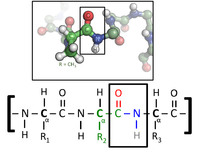

Def. "[a]n amide bond formed between the amino and carboxyl functional groups of separate amino acids"[7] is called a peptide bond.
Def. "various numbers of amino acids in which the amine of one is reacted with the carboxylic acid of the next to form an amide bond"[8] is called a peptide.
Def. "two amino acids joined by a peptide bond"[9] is called a dipeptide.
Def. "three amino acids joined by peptide bonds"[10] is called a tripeptide.
Def. four amino acids joined by peptide bonds is called a tetrapeptide.
Def. five amino acids joined by peptide bonds is called a pentapeptide.
Def. "[a] peptide containing a relatively small number of amino acids"[11] is called an oligopeptide.
Def. "[a]ny polymer of (same or different) amino acids joined via peptide bonds"[12] is called a polypeptide.
In the diagram at top right, the remainder of the carboxyl group (C = O) has been bonded to the the remainder of the amino group (NH) of an adjacent amino acid by a peptide bond. The remainder of the carbonyl group and amino group has been formed into H2O ← OH (from -C=O·OH) + H (from NH2-).
The second from the top diagram shows the amino group end (or N-terminus) in green and the carboxyl group end (or C-terminus) in blue of a tetrapeptide ([Valine] Val-[Glycine] Gly-[Serine] Ser-[Alanine] Ala).
"The convention for writing peptide sequences is to put the N-terminus on the left and write the sequence from N- to C-terminus."[13]
Preproteins
Def. any protein or polypeptide containing a signal sequence that specifies its insertion into or through membranes is called a preprotein.
Def. any preprotein of a proprotein is called a preproprotein.
Proproteins
Def. "[a]ny protein that is cleaved by a convertase to form a smaller protein or biologically-active polypeptide"[14] is called a proprotein.
Proteoses
Def. a "mixture of peptides produced by the hydrolysis of proteins"[15] is called a proteose.
Peptones
Def. any "water-soluble product, a mixture of polypeptides and amino acids formed by the partial hydrolysis of protein"[16] is called a peptone.
Albumins

Def. a "class of monomeric proteins that are soluble in water, and are coagulated by heat; they occur in egg white, milk etc; they function as carrier protein for steroids, fatty acids, and thyroid hormones and play a role in stabilizing extracellular fluid volume"[17] is called albumins.
Globulins
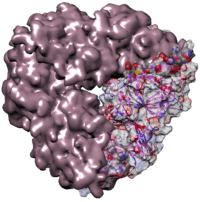
Def. any "of a group of simple proteins, soluble in water only in the presence of salts, that are coagulated by heat; one of the two parts of hæmoglobin"[18] is called a globulin.
Prolamins
Def. any "of a group of plant storage proteins, that have a high proline content, found in cereals"[19] is called a prolamin.
Histones
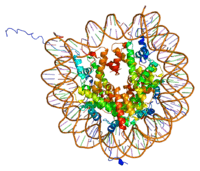
Def. any "of various simple water soluble proteins that are rich in the basic amino acids lysine and arginine and are complexed with DNA in the nucleosomes of eukaryotic chromatin"[20] is called a histone.
Protamines
Def. "any of a class of proteins, rich in arginine, found in the sperm of fish; used medicinally to control the action of insulin"[21] is called a protamine.
Conjugated proteins
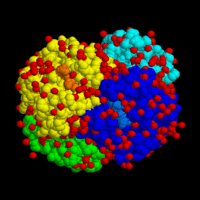
Def. any "protein that consists of both a polypeptide and a prosthetic group such as a lipid (in lipoproteins), sugar (in glycoproteins) or porphyrins and metals (in hemoglobin etc)"[22] is called a conjugated protein.
Cytochromes
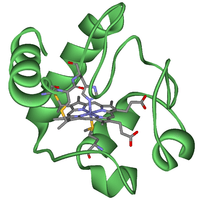
Def. any "of various related hemoproteins found in the cells of most organisms, which are an important part of cell respiration"[23] is called a cytochrome.
Flavoproteins
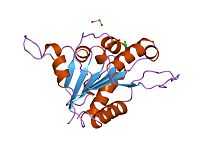
Def. "any of a group of enzymes, containing flavin, that act as dehydrogenases"[24] is called a flavoprotein.
Glycoproteins

Def. a "protein with covalently bonded carbohydrates"[25] is called a glycoprotein.
Hemeproteins
Def. any "conjugated protein containing heme as the prosthetic group"[26] is called a hemeprotein.
Lipoproteins


Def. any "of a large group of complexes of protein and lipid with many biochemical functions"[27] is called a lipoprotein.
Metalloproteins
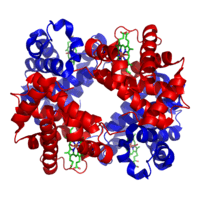
Def. "a protein, such as haemoglobin or chlorophyll, that contains a metal atom as a cofactor"[28] is called a metalloprotein.
Opsins

Def. any "of a group of light-sensitive proteins in the retina"[29] is called an opsin.
Phosphoproteins
Def. "any protein containing bound phosphate"[30]is called a phosphoprotein.
Phytochromes
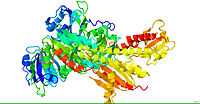
Def. any "of a class of pigments that control most photomorphogenic responses in higher plants"[31] is called a phytochrome.
Scleroproteins

Def. any "of many fibrous proteins found in connective tissue etc"[32] is called a scleroprotein.
Research
Hypothesis:
- Amino acids in addition to the critical 22 are also coded genetically.
Control groups

The findings demonstrate a statistically systematic change from the status quo or the control group.
“In the design of experiments, treatments [or special properties or characteristics] are applied to [or observed in] experimental units in the treatment group(s).[33] In comparative experiments, members of the complementary group, the control group, receive either no treatment or a standard treatment.[34]"[35]
Proof of concept
Def. a “short and/or incomplete realization of a certain method or idea to demonstrate its feasibility"[36] is called a proof of concept.
Def. evidence that demonstrates that a concept is possible is called proof of concept.
The proof-of-concept structure consists of
- background,
- procedures,
- findings, and
- interpretation.[37]
See also
- Biochemistry/Proteins
- Biosynthesis of a human protein
- Biosynthesis of amino acids
- Factor
- Folding
- Food
- Post translational modification
- Principles of biosynthesis
References
- 1 2 "amino acid, In: Wiktionary". San Francisco, California: Wikimedia Foundation, Inc. August 29, 2012. Retrieved 2012-10-03.
- ↑ "amine, In: Wiktionary". San Francisco, California: Wikimedia Foundation, Inc. November 18, 2013. Retrieved 2013-11-29.
- ↑ "carboxyl, In: Wiktionary". San Francisco, California: Wikimedia Foundation, Inc. August 29, 2012. Retrieved 2012-10-03.
- ↑ Ambrogelly A, Palioura S, Söll D (January 2007). "Natural expansion of the genetic code". Nat Chem Biol 3 (1): 29–35. doi:10.1038/nchembio847. PMID 17173027. http://www.nature.com/nchembio/journal/v3/n1/abs/nchembio847.html.
- 1 2 "Proteinogenic amino acid, In: Wikipedia". San Francisco, California: Wikimedia Foundation, Inc. September 3, 2012. Retrieved 2012-10-03.
- ↑ Erives A (2011). "A Model of Proto-Anti-Codon RNA Enzymes Requiring L-Amino Acid Homochirality". J Molecular Evolution 73: 10-22. doi:10.1007/s00239-011-9453-4. PMID 21779963.
- ↑ "peptide bond, In: Wiktionary". San Francisco, California: Wikimedia Foundation, Inc. August 29, 2012. Retrieved 2012-10-01.
- ↑ "peptide, In: Wiktionary". San Francisco, California: Wikimedia Foundation, Inc. August 30, 2012. Retrieved 2012-10-01.
- ↑ "dipeptide, In: Wiktionary". San Francisco, California: Wikimedia Foundation, Inc. August 30, 2012. Retrieved 2012-10-01.
- ↑ "tripeptide, In: Wiktionary". San Francisco, California: Wikimedia Foundation, Inc. August 30, 2012. Retrieved 2012-10-01.
- ↑ "oligopeptide, In: Wiktionary". San Francisco, California: Wikimedia Foundation, Inc. August 30, 2012. Retrieved 2012-10-01.
- ↑ "polypeptide, In: Wiktionary". San Francisco, California: Wikimedia Foundation, Inc. August 30, 2012. Retrieved 2012-10-01.
- ↑ "N-terminus, In: Wikipedia". San Francisco, California: Wikimedia Foundation, Inc. April 26, 2012. Retrieved 2012-10-03.
- ↑ "proprotein, In: Wiktionary". San Francisco, California: Wikimedia Foundation, Inc. August 14, 2008. Retrieved 2012-10-03.
- ↑ "proteose, In: Wiktionary". San Francisco, California: Wikimedia Foundation, Inc. June 18, 2013. Retrieved 2013-11-29.
- ↑ "peptone, In: Wiktionary". San Francisco, California: Wikimedia Foundation, Inc. November 10, 2013. Retrieved 2013-11-29.
- ↑ "albumin, In: Wiktionary". San Francisco, California: Wikimedia Foundation, Inc. October 18, 2013. Retrieved 2013-11-29.
- ↑ "title, In: Wiktionary". San Francisco, California: Wikimedia Foundation, Inc. October 8, 2013. Retrieved 2013-11-29.
- ↑ "prolamin, In: Wiktionary". San Francisco, California: Wikimedia Foundation, Inc. June 18, 2013. Retrieved 2013-11-29.
- ↑ "histone, In: Wiktionary". San Francisco, California: Wikimedia Foundation, Inc. October 7, 2013. Retrieved 2013-11-29.
- ↑ "protamine, In: Wiktionary". San Francisco, California: Wikimedia Foundation, Inc. June 18, 2013. Retrieved 2013-11-29.
- ↑ "conjugated protein, In: Wiktionary". San Francisco, California: Wikimedia Foundation, Inc. June 18, 2013. Retrieved 2013-11-29.
- ↑ Widsith and SemperBlotto (25 May 2010). "cytochrome, In: Wiktionary". San Francisco, California: Wikimedia Foundation, Inc. Retrieved 2015-07-10.
- ↑ SemperBlotto (23 April 2006). "flavoprotein, In: Wiktionary". San Francisco, California: Wikimedia Foundation, Inc. Retrieved 2015-07-10.
- ↑ Jag123 and SemperBlotto (9 March 2005). "glycoprotein, In: Wiktionary". San Francisco, California: Wikimedia Foundation, Inc. Retrieved 2015-07-09.
- ↑ SemperBlotto (18 April 2008). "hemeprotein, In: Wiktionary". San Francisco, California: Wikimedia Foundation, Inc. Retrieved 2015-07-10.
- ↑ SemperBlotto (29 June 2005). "lipoprotein, In: Wiktionary". San Francisco, California: Wikimedia Foundation, Inc. Retrieved 2015-07-09.
- ↑ SemperBlotto (3 November 2005). "metalloprotein, In: Wiktionary". San Francisco, California: Wikimedia Foundation, Inc. Retrieved 2015-07-10.
- ↑ SemperBlotto (20 February 2007). "opsin, In: Wiktionary". San Francisco, California: Wikimedia Foundation, Inc. Retrieved 2015-07-10.
- ↑ SemperBlotto (22 November 2006). "phosphoprotein, In: Wiktionary". San Francisco, California: Wikimedia Foundation, Inc. Retrieved 2015-07-10.
- ↑ SemperBlotto (11 April 2008). "phytochrome, In: Wiktionary". San Francisco, California: Wikimedia Foundation, Inc. Retrieved 2015-07-10.
- ↑ "scleroprotein, In: Wiktionary". San Francisco, California: Wikimedia Foundation, Inc. June 18, 2013. Retrieved 2013-11-29.
- ↑ Klaus Hinkelmann, Oscar Kempthorne (2008). Design and Analysis of Experiments, Volume I: Introduction to Experimental Design (2nd ed.). Wiley. ISBN 978-0-471-72756-9. http://books.google.com/?id=T3wWj2kVYZgC&printsec=frontcover.
- ↑ R. A. Bailey (2008). Design of comparative experiments. Cambridge University Press. ISBN 978-0-521-68357-9. http://www.cambridge.org/uk/catalogue/catalogue.asp?isbn=9780521683579.
- ↑ "Treatment and control groups, In: Wikipedia". San Francisco, California: Wikimedia Foundation, Inc. May 18, 2012. Retrieved 2012-05-31.
- ↑ "proof of concept, In: Wiktionary". San Francisco, California: Wikimedia Foundation, Inc. November 10, 2012. Retrieved 2013-01-13.
- ↑ Ginger Lehrman and Ian B Hogue, Sarah Palmer, Cheryl Jennings, Celsa A Spina, Ann Wiegand, Alan L Landay, Robert W Coombs, Douglas D Richman, John W Mellors, John M Coffin, Ronald J Bosch, David M Margolis (August 13, 2005). "Depletion of latent HIV-1 infection in vivo: a proof-of-concept study". Lancet 366 (9485): 549-55. doi:10.1016/S0140-6736(05)67098-5. http://www.ncbi.nlm.nih.gov/pmc/articles/PMC1894952/. Retrieved 2012-05-09.
External links
- African Journals Online
- Bing Advanced search
- GenomeNet KEGG database
- Google Books
- Google scholar Advanced Scholar Search
- Home - Gene - NCBI
- JSTOR
- Lycos search
- NCBI All Databases Search
- NCBI Site Search
- Office of Scientific & Technical Information
- PubChem Public Chemical Database
- Questia - The Online Library of Books and Journals
- SAGE journals online
- Scirus for scientific information only advanced search
- SpringerLink
- Taylor & Francis Online
- WikiDoc The Living Textbook of Medicine
- Wiley Online Library Advanced Search
- Yahoo Advanced Web Search
| |||||||||||||||||||||||||||||||||||
| |||||||||||||||||||||||||||||||||||||||||
| |||||||||||||||||||||||||||||||||||
![]() This is a research project at http://en.wikiversity.org
This is a research project at http://en.wikiversity.org
| |
Development status: this resource is experimental in nature. |
| |
Educational level: this is a research resource. |
| |
Resource type: this resource is an article. |
| |
Resource type: this resource contains a lecture or lecture notes. |
| |
Subject classification: this is a biochemistry resource. |
| |
Subject classification: this is a medicine resource. |